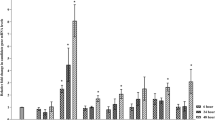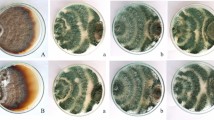Abstract
The effects of ozone on the susceptibility of leaves ofPhaseolus vulgaris toSclerotinia sclerotiorum andBotrytis cinerea have been investigated. Seedlings of one ozone-sensitive (‘Pros’) and five relatively ozone-insensitive cultivars (‘Gamin’, ‘Precores’, ‘Groffy’, ‘Narda’, ‘Berna’) were exposed to different ozone concentrations (0, 120, 180 and 270 μg m−3) for 8 h. One day after the exposures, primary leaves were detached and immediately inoculated with spores of either pathogen suspended in water or in a 62.5 mM KH2PO4 (Pi) solution. Visible ozone injury differed between the cultivars and increased with increasing ozone concentration. On the leaves of non-exposed plants, spores of the pathogens suspended in water caused very few lesions, whereas fungal pathogenicity was stimulated by addition of Pi to the inoculum. Ozone-injured leaves of all cultivars exhibited lesions after inoculation of the leaves with the pathogens suspended in water, and the number of lesions was positively correlated with the level of ozone injury for either pathogen and cultivar. The increase in susceptibility of bean leaves in response to increasing ozone concentrations was greater forB. cinerea than forS. sclerotiorum when spores were suspended in water, but was similar when the spores were suspended in Pi.
In general, the number of lesions following inoculation with spores in Pi increased with increasing ozone concentration. However, the number of lesions in the ozone-insensitive ‘Groffy’ was reduced by an exposure to 120 μg m−3 but increased with higher concentrations. This pattern of susceptibility response to the pathogens was not found in the other ozone-insensitive cultivars and, thus, did not appear to be related to the inherent ozone-insensitivity in bean.
Similar content being viewed by others
References
Abawi, G.S. & Grogan, R.G., 1979. Epidemiology of diseases caused bySclerotinia species. Phytopathology 69:899–904.
Abawi, G.S., Provvidenti, R., Grogan, R.G. & Hunter, J.E., 1975. Predisposition of beans to infection by ascospores ofWhetzelinia sclerotiorum prior to blossoming. Proceedings of the American Phytopathological Society 2:61 (Abstr.).
Archer, S.A., Mitchell, S.J. & Wheeler, B.E.J., 1992. The effects of rotation and other cultural factors onSclerotinia in oilseed rape, peas and potatoes. Proceedings Brighton Crop Protection Conference-Pests and Diseases-1992: 99–108.
Blakeman, J.P., 1980. Behaviour of conidia on aerial plant surfaces. In: Coley-Smith, J.R., Verhoeff, K. & Jarvis, W.R. (Eds), The biology ofBotrytis. Academic Press, New York, London. p. 115–152.
Clark, C. A. & Lorbeer, J.W., 1977. Comparative nutrient dependency ofBotrytis squamosa andB. cinerea for germination of conidia and pathogenicity on onion leaves. Phytopathology 67: 212–218.
Hall, R. (Ed.), 1991. Compendium of bean diseases. APS Press, St. Paul. pp. 73.
Hofstra, G. & Ormrod, D.P., 1977. Ozone and sulphur dioxide interaction in white bean and soybean. Canadian Journal of Plant Science 57:1193–1198.
Leone, G., 1992. Significance of polygalacturonase production byBotrytis cinerea in pathogenesis. In: Verhoeff, K., Malathrakis, N.E. & Williamson, B. (Eds), Recent advances inBotrytis research. Proceedings of the 10th InternationalBotrytis Symposium, Heraklion, Crete, Greece, 5–10 April 1992. Pudoc Scientific Publishers, Wageningen. p. 63–68.
Leone, G. & Tonneijck, A.E.G., 1990a. Acute ozone exposure predisposePhaseolus vulgaris beans toBotrytis cinerea. Netherlands Journal of Plant Pathology 96: 65–74.
Leone, G. & Tonneijck, A.E.G., 1990b. A rapid procedure for screening the resistance of bean cultivars (Phaseolus vulgaris L.) toBotrytis cinerea andSclerotinia sclerotiorum. Euphytica 48: 87–90.
Lohuis, H., 1991.Selerotinia sclerotiorum, de veroorzaker van de rattekeutelziekte. Dossier Gewasbescherming 14: 14–16.
Manning, W.J., 1976. The influence of ozone on plant surface micro-floras. In: Dickinson, C.H. & Preece, T.F. (Eds), Microbiology of aerial plant surfaces. Academic Press, New York, London. p. 159–172.
Manning, W.J., Feder, W.A. & Perkins, I., 1970. Ozone injury increases infection of geranium leaves byBotrytis cinerea. Phytopathology 60:669–670.
Manning, W.J., Feder, W.A., Perkins, I. & Glickman, M., 1969. Ozone injury and infection of potato leaves byBotrytis cinerea. Plant Disease Reporter 53:691–693.
Mc Cullagh, P. & Nelder, J.A., 1983. Generalized linear models. Chapman and Hall, London, pp. 261.
McKersie, B.D., Hucl, P. & Beversdorf, W.D., 1982. Solute leakage from susceptible and tolerant cultivars ofPhaseolus vulgaris following ozone exposure. Canadian Journal of Botany 60:73–78.
Mooi, J. & Jolink, H.H.W., 1989. Computer controlled plant growth cabinets for fumigation experiments. In: Payer, H.D., Pfirrmann, T. & Mathy, P. (Eds), Environmental research with plants in closed chambers. Air Pollution Report Series of the Environmental Research Programme of the Commission of the European Communities 26. p. 43–51.
Purdy, L.H., 1979.Sclerotinia sclerotirum: History, diseases and symptomatology, host range, geographic distribution, and impact. Phytopathology 69:875–880.
Rist, D.L. & Lorbeer, J.W., 1984a. Moderate dosages of ozone enhance infection of onion leaves byBotrytis cinerea but not byBotrytis squamosa. Phytopathology 74:761–767.
Rist, D.L. & Lorbeer, J.W., 1984b. Ozone-enhanced leaching of onion foliage in relation to lesion production byBotrytis cinerea. Phytopathology 74: 1217–1220.
Slooff, W., Van Aalst, R.M., Heijna-Merkus, E. & Thomas, R. (Eds), 1989. Integrated criteria document ozone. Report no. 758474002, National Institute of Public Health and Environmental Protection, Bilthoven, the Netherlands. pp. 146.
Steadman, J.R., 1983. White mold—A serious yield-limiting disease of bean. Plant Disease 67: 346–350.
Sutherland, M.W., 1991. The generation of oxygen radicals during host plant responses to infection. Physiological and Molecular Plant Pathology 39: 79–93.
Thompson, J.E., Legge, R.L. & Barber, R.F., 1987. The role of free radicals in senescence and wounding. New Phytologist 105:317–344.
Tonneijck, A.E.G., 1983. Foliar injury responses of 24 bean cultivars (Phaseolus vulgaris) to various concentrations of ozone. Netherlands Journal of Plant Pathology 89: 99–104.
Tonneijck, A.E.G., 1993. Effects of various ozone exposures on the susceptibility of bean leaves (Phaseolus vulgaris L.) toBotrytis cinerea. Environmental Pollution, in press.
Wukasch, R.T. & Hofstra, G., 1977a. Ozone andBotrytis interactions in onion leaf dieback: field studies. Journal of the American Society for Horticultural Science 102: 543–546.
Wukasch, R.T. & Hofstra, G., 1977b. Ozone andBotrytis interactions in onion-leaf dieback: Opentop chamber studies. Phytopathology 67: 1080–1084.
Author information
Authors and Affiliations
Rights and permissions
About this article
Cite this article
Tonneijck, A.E.G., Leone, G. Changes in susceptibility of bean leaves (Phaseolus vulgaris) to Sclerotinia sclerotiorum and Botrytis cinerea by pre-inoculative ozone exposures. Netherlands Journal of Plant Pathology 99, 313–322 (1993). https://doi.org/10.1007/BF01974312
Accepted:
Issue Date:
DOI: https://doi.org/10.1007/BF01974312




